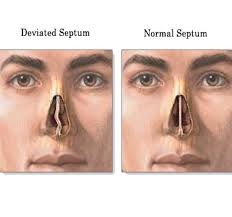Surgical Septoplasty
Septoplasty is performed to straighten a deviated, or crooked nasal septum.
Benefits of surgery
People benefit from a septoplasty when they have:
• A significant nasal septal abnormality and blocked nasal breathing
• Not had adequate symptom relief wth medications
Goals of surgery
The primary goal of septoplasty surgery is to improve breathing through the nose. Secondarily, some patients may experience improvement in the areas of:
• Nasal discharge
• Post-nasal drip
Surgical Treatment
Septoplasty surgery is performed under general anesthesia.Through an incision made inside the nostril, the tissue (mucosa) covering the septum is lifted up to allow the surgeon to see the bone and cartilage directly. The deviated portions of the bone and cartilage are then either removed or reshaped, leaving behind enough nondeviated bone and cartilage to maintain the shape of the nose. The incision is then stitched closed.Your surgeon may place soft plastic sheets or splints inside the nose to help the septum heal straight and reduce the chance of scar tissue formation. Packing is rarely used in the nose to help prevent bleeding.Your surgeon will tell you when the packing and/or splints are to be removed. The surgery will probably last from one to three hours. Once the effects of the anesthesia have worn off, patients are discharged home later the same day.For some patients, turbinate reduction may be done during the same surgery. Your doctor will discuss this option with you.Septoplasty does not involve cutting through the skin, as it is performed entirely through the nostrils. Therefore, most people can go home the same day.







